Cumbres and Toltec Scenic Railroad
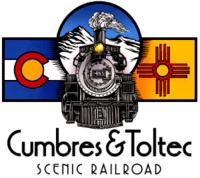 | |
| Locale |
Conejos County and Archuleta County in Colorado and Rio Arriba County in New Mexico, United States |
|---|---|
| Dates of operation | 1970–present |
| Track gauge | 3 ft (914 mm) |
| Length | 64 miles |
| Headquarters | Chama, New Mexico |
| Website | |
|
Denver & Rio Grande Railroad San Juan Extension | |
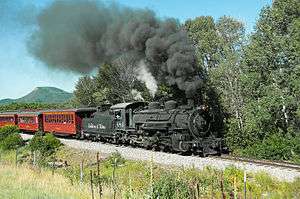 | |
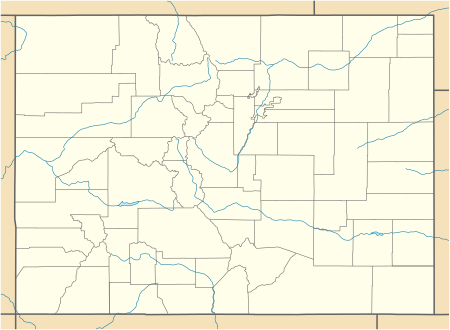  | |
| Nearest city | Antonito, Colorado and Chama, New Mexico |
| Coordinates | 36°54′N 106°35′W / 36.900°N 106.583°WCoordinates: 36°54′N 106°35′W / 36.900°N 106.583°W |
| Area | 1,430 acres (580 ha) |
| Built | 1880 |
| Architect |
Denver and Rio Grande Western Railroad Baldwin Locomotive Works |
| Architectural style | Late 19th And Early 20th Century American Movements |
| MPS | Railroads in Colorado, 1858-1948 MPS |
| NRHP reference # |
73000462[1] (original) 07000374[1] (increase) |
| CSRHP # | 5AA.664 / 5CN.65 |
| NMSRCP # | 136 |
| Significant dates | |
| Added to NRHP | February 16, 1973 |
| Boundary increase | April 24, 2007 |
| Designated NHLD | October 16, 2012[2][3] |
| Designated NMSRCP | November 20, 1969 |
The Cumbres & Toltec Scenic Railroad (C&TS) is a 3 ft (914 mm) narrow-gauge heritage railroad running for 64 miles (103 km) between Antonito, Colorado and Chama, New Mexico, United States. The railroad gets its name from two geographical features along the route, the 10,015 ft (3,053 m) high Cumbres Pass and Toltec Gorge. Originally part of the Denver and Rio Grande Western Railroad's narrow-gauge network, the line has been jointly owned by the states of Colorado and New Mexico since 1970.
History
The rail line over which the Cumbres & Toltec operates was constructed in 1881 by the Denver and Rio Grande Western Railroad (D&RGW) as part of their San Juan extension stretching from Alamosa, Colorado to Durango, Colorado. The line was originally built to support mining operations in the San Juan Mountains, mainly around Durango and Silverton. By the mid 20th century, the ore traffic had dwindled but the line continued to support various agricultural and industrial operations until the 1960s.
In 1968, freight traffic was virtually gone and the railroad began the process of abandoning the line. However, the states of Colorado and New Mexico purchased the 64 mile portion between Antonito and Chama in 1970 and began excursion services on the route as the Cumbres & Toltec Scenic Railroad.[4]
Current operations
The Cumbres & Toltec Scenic Railroad operates between late May and late October with two trains (one in each direction) departing each morning from Antonito and Chama. Both trains are timed to meet at Osier, an old section town located about halfway along the route, for a lunch stop. Afterwards, passengers continue with their train to its destination or switch trains to return to their original terminal. Through riders are returned to their starting place by motorcoach after the train arrives at its destination.
In addition to the through service, the C&TS operates various special excursions during the season such as dinner trains.[5]
Operator changes
After the Cumbres & Toltec Scenic Railroad was formed, a bi-state agency, the Cumbres & Toltec Scenic Railroad Commission was created and railroad operations were then contracted to third party rail operators. In 2012, the Commission formed its own operating company, Cumbres & Toltec Operating LLC,[6] with the hiring of John Bush as president on December 13, 2012.[7]
Friends of the C&TS
In 1988, a nonprofit organization called Friends of the Cumbres & Toltec Scenic Railroad was established to preserve the history of the railroad and help maintain infrastructure and rolling stock. The Friends of the C&TS also participate in various education programs and provides the railroad guides, known as docents, who inform passengers about historical aspects of the railroad as well as locations of interest.[8]
Notable incidents
2002 shutdowns
In 2002, the C&TS was shut down twice, first in the spring to resolve track bed issues. In the summer, operations were suspended again because of wildfire dangers.[9]
Lobato trestle fire
On June 23, 2010, an unknown fire severely damaged Lobato Trestle, a deck girder bridge located about 4 miles east of Chama. While the bridge was out of order, the C&TS operated limited services from the Chama end while trains from Antonito only traveled to Osier and back.[10] After undergoing extensive refurbisment, the bridge was reopened on June 20, 2011.[11]
National Historic Landmark
In 1973, the Cumbres & Toltec was listed on the National Register of Historic Places, and the boundaries were increased in 2007.[1] In 2012, the railroad was designated a National Historic Landmark.
Rolling stock
Locomotives
All of the steam locomotives currently operating on the C&TS are former Denver and Rio Grande Western 2-8-2 outside frame engines built by the Baldwin Locomotive Works in the early 1900s. Among these are K-27 #463, the K-36 class, and the slightly larger K-37 class engines. In addition to the steam locomotives, the C&TS also operates two GE 47-ton switchers for light duties.[12]
D&RGW #168
In 2015, D&RGW #168, a 4-6-0 steam locomotive, was transported from Colorado Springs to the C&TS shops in Antonito to be restored to operating condition. The 168 is one of two surviving class T-12 locomotives built for the D&RGW between 1883 and 1885. The other T-12, D&RGW #169, is on static display in Alamosa, Colorado, and is not operational.[13]
Passenger Cars
For passenger services, the Cumbres & Toltec operates a mixture of flat roofed and clerestory cars with interiors corresponding with the railroad's three classes of service: Coach, Tourist, and Parlor. The C&TS also operates special coaches configured to accommodate wheelchairs and house concession areas.[14]
In popular culture
Over the years, the railroad was featured in several documentaries and films.[15] Among these are:
- Bite the Bullet, 1975
- Indiana Jones and the Last Crusade, 1989
- Ghost Trains of the Old West, 1990[16]
- America's Historic Steam Railroads: Cumbres & Toltec Scenic Railroad, 1999[17]
- A Million Ways to Die in the West, 2014
- Hostiles, 2017[5]
Route description
| Cumbres and Toltec Scenic Railroad | ||||||||||||||||||||||||||||||||||||||||||||||||||||||||||||||||||||||
|---|---|---|---|---|---|---|---|---|---|---|---|---|---|---|---|---|---|---|---|---|---|---|---|---|---|---|---|---|---|---|---|---|---|---|---|---|---|---|---|---|---|---|---|---|---|---|---|---|---|---|---|---|---|---|---|---|---|---|---|---|---|---|---|---|---|---|---|---|---|---|
| ||||||||||||||||||||||||||||||||||||||||||||||||||||||||||||||||||||||
Locations along the line
- Chama, New Mexico 36°54′N 106°35′W / 36.900°N 106.583°W
- Cumbres Pass 37°1′N 106°27′W / 37.017°N 106.450°W
- Osier, Colorado 37°1′N 106°20′W / 37.017°N 106.333°W
- Toltec Gorge, New Mexico 36°59′N 106°18′W / 36.983°N 106.300°W
- Sublette Station 36°59′N 106°14′W / 36.983°N 106.233°W
- Antonito, Colorado 37°4′N 106°1′W / 37.067°N 106.017°W
Chama to Osier
Beginning in Chama (Milepost 344.12), the railroad proceeds northeast after leaving the yard and crossing the Rio Chama. About a mile later begins a 4% grade which is nearly constant from there to Cumbres. The first siding on the line is located at Lobato (MP: 339.99), located here are the remnants of a stock pen, and a water tank made for a movie in the 1970s. The tank was used later in Indiana Jones and the Last Crusade. The water tank was knocked over in 2006, due to age and high winds. Just under a quarter of a mile away, is Lobato Trestle, the second-highest trestle on the line, built in 1883. Due to weight restrictions, only one locomotive at a time is allowed to cross; therefore, all double-headers must separate, and rejoin on the other side.
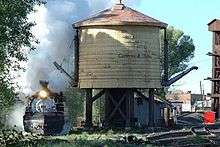
From here to Cumbres, the railroad operates on the north side of Wolf Creek. On the journey to the top at Cumbres, the train passes Cresco Siding and water tank (MP 335.10) and navigates a small canyon past Hamilton's Point. Exiting the canyon, the track makes a turn to the northwest and up the Wolf Creek drainage through Coxo. At a narrow point of the valley, the track makes a horseshoe turn up to Windy Point, which the train rounds to enter Cumbres Pass.
At Cumbres (MP 330.48), elevation 10,015 ft (3,053 m), is the Car Inspector's House, Water Standpipe, remnants of the extensive snow shed, and the Section House, which replaced the original depot after it was demolished in the 1950s. Cumbres is the highest point on the railroad. From here east, the track heads down at 2.5%, and descends the Cumbres Loop, more commonly refer to as "Tanglefoot Curve". After exiting the loop, the track follows a general easterly direction until Milepost 327.6, where they turn north up the Los Piños Valley.
Heading north, the track loses elevation, while the valley slopes up, with the track and valley floor finally meeting at Mile 325, where the track once again changes direction, heading south on the other side of the valley, following the Rio de Los Piños toward Osier. After Mile 323, the track again leaves the valley, on a much steeper grade, while the track clings to the valley created by the river. Along the way, the track crosses Cascade Trestle (MP 319.95), taller than the Lobato Trestle, at 137 ft (42 m). Approximately a mile and a half later, the track enters Osier, Colorado, the midpoint of the railroad where the two trains meet for lunch. Here, riders may switch trains and return to their point of origin, or ride to the opposing terminus.
Antonito to Osier
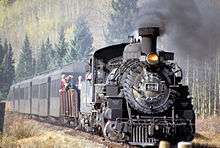
This section covers the eastern portion of the line from the small cattle and junction town of Antonito to Osier, the midpoint of the line.
Antonito (MP 280.70) is a small company town of the former railroad main line. It is home to the C&TS car shop, a water tank, and other relics. Most of the facilities were built by the Cumbres & Toltec, as the original rail yard, wye, and station were not sold to the states of Colorado and New Mexico.
Shortly after leaving the station, the train heads straight for 3 miles (4.8 km), until coming into some hills. Shortly thereafter, the train crosses Ferguson's Trestle (MP 285.87), named for a man who was hung from a locomotive there. The original trestle was featured in the 1988 television movie Where the Hell's That Gold?, starring Willie Nelson and Delta Burke. In filming, a planned explosion ended up getting out of hand and the bridge was burned down. Traffic was halted for a week while the C&TS built a temporary bridge; the following winter it rebuilt the trestle to match the original. About three miles (5 km) later, the train makes the first of 11 crossings into New Mexico, and climbs a ledge up to a lava mesa. Lava (291.55) has the old water tank from Antonito, which was moved here in 1971. The track goes around a horseshoe curve that is also used as a reversing loop to turn the rotary snow plow trains from Chama. The Cumbres & Toltec has two rotary snowplows — Rotary OM and Rotary OY.
Heading west, the track rounds Whiplash Curve, a double horseshoe curve. About a mile from Whiplash Curve lie the sidings and wye at Big Horn. Past Big Horn the train loops around the sides of mountains going through horseshoe curves before reaching the first water stop at Sublette.
Sublette is an abandoned railroad section camp, consisting of a log bunk house, a section house, a siding, and other buildings. There used to be a water tank at the western end of the siding, but today, in its place, is a standpipe. After filling the tender with water, the engine and the train slowly creep into lush aspen groves.
After departing Sublette comes Toltec Siding, which in the 1950s was the meeting place of long oil well pipe trains moving between Chama and Farmington to Alamosa. Shortly afterwords, trains pass through Mud Tunnel, which is unique, because it is lined with wooden pillars, since it is bored through soft volcanic ash. When the beams in the tunnel collapsed, the D&RGW made a "shoo fly" around the tunnel to allow passengers and small cars to be moved around the tunnel to an awaiting train. After passing through this, trains pass around Phantom Curve and through Calico Cut, and then the trains slow down as they enter the longer Rock Tunnel. Trains exit the tunnel, entering the Toltec Gorge, where the track is 600 ft (180 m) above the river. The line follows the river the remainder of the distance to Osier.
See also
- D & RG Narrow Gauge Trestle
- Heber Valley Railroad
- List of Colorado historic railroads
- List of Denver and Rio Grande Western Railroad lines
- List of heritage railroads in the United States
- Narrow-gauge railroads in the United States
- San Juan Express
- National Register of Historic Places listings in Colorado § Archuleta County
- National Register of Historic Places listings in Conejos County, Colorado
- National Register of Historic Places listings in Rio Arriba County, New Mexico
- List of National Historic Landmarks in Colorado
- List of National Historic Landmarks in New Mexico
References
- 1 2 3 National Park Service (2010-07-09). "National Register Information System". National Register of Historic Places. National Park Service.
- ↑ "National Historic Landmarks Survey, Colorado" (PDF). National Park Service. Retrieved December 11, 2016.
- ↑ "National Historic Landmarks Survey, New Mexico" (PDF). National Park Service. Retrieved December 11, 2016.
- ↑ "DRGW.Net | The San Juan Extension". www.drgw.net. Retrieved 2018-05-26.
- 1 2 Railroad, The Cumbres & Toltec Scenic. "Full Steam Ahead! Make 2018 Your Year to Ride the Cumbres & Toltec Scenic Railroad!". GlobeNewswire News Room. Retrieved 2018-05-27.
- ↑ "16cumbres.html".
- ↑ "New President - Cumbres & Toltec Scenic Railroad". Cumbres & Toltec Scenic Railroad. 2012-12-05. Retrieved 2018-05-27.
- ↑ "Friends of the Cumbres and Toltec Scenic Railroad". Center for Nonprofit Excellence in Central New Mexico. Retrieved 2018-05-27.
- ↑ "Colorado Central Magazine - The monthly magazine for the illuminated - Cumbres & Toltec will steam on this summer". Cozine.com. 2003-06-01. Retrieved 2015-05-01.
- ↑ "Fire hits Cumbres and Toltec train line". The Denver Post. 2010-06-24. Retrieved 2018-05-28.
- ↑ Writer, Juan Carlos Rodriguez | Journal Staff. "Scenic Railroad Back in Service". www.abqjournal.com. Retrieved 2018-05-28.
- ↑ "Cumbres & Toltec Scenic RR". donsdepot.donrossgroup.net. Retrieved 2018-05-26.
- ↑ "Cumbres & Toltec Scenic Announces Lease To Fully Restore T-12 Engine 168". www.corailroads.com. Retrieved 2018-05-28.
- ↑ "www.trainweb.org/chris/16cumbres.html".
- ↑ Arellano, Megan. "A 'Hateful' Question: What Movies Were Filmed In Colorado, But Set Elsewhere?". Colorado Public Radio. Retrieved 2018-05-27.
- ↑ "GHOST TRAINS OF THE OLD WEST (105929-01) lifeisamovie.com". shop.lifeisamovie.com. Retrieved 2018-05-27.
- ↑ "America's Historic Steam Railroads: Cumbres & Toltec Scenic Railroad - Movie Reviews - Rotten Tomatoes". www.rottentomatoes.com. Retrieved 2018-05-27.
External links
| Wikimedia Commons has media related to Cumbres and Toltec Scenic Railroad. |

